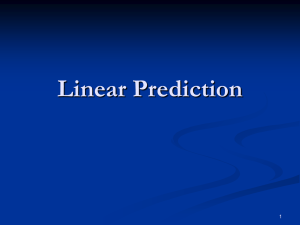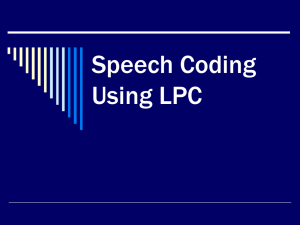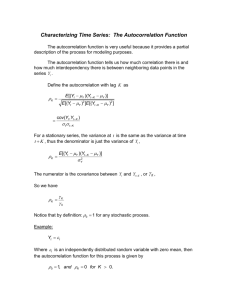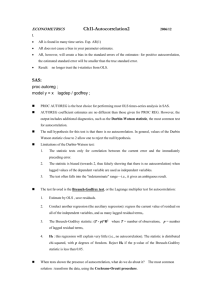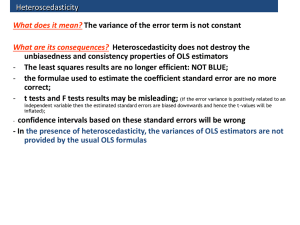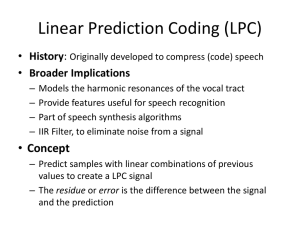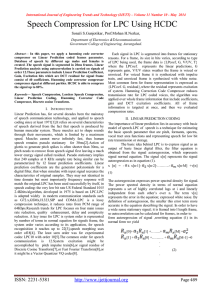linear Prediction - University of Kentucky
advertisement
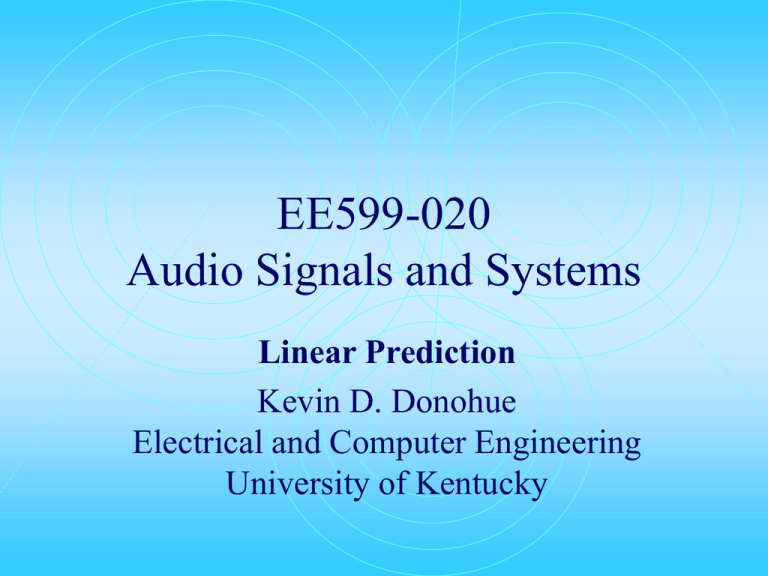
EE599-020 Audio Signals and Systems Linear Prediction Kevin D. Donohue Electrical and Computer Engineering University of Kentucky Related Web Sites Linear Prediction Coding (LPC) has been a popular modeling, analysis and synthesis tool for speech the 1970’s. Many web sites are devoted to education and research in this area. A general search of Linear Prediction … will turn up many interesting web sites. A few examples are given below: http://www.otolith.com/pub/u/howitt/lpc.tutorial.html http://www.dcs.shef.ac.uk/~martin/MAD/lpcspect/lpcspect.htm http://www.speex.org/manual/node8.html LPC Derivation Derive an algorithm to compute LPC coefficients from a stream of data that minimizes the mean squared prediction error. Let x ( n ) for 0 n N- 1 be the sequence of data points and a(m ) for 1 m p be the m-th order LPC coefficients, and xˆ ( n ) be the prediction estimate. The mean squared error for the prediction is given by: mse 1 N N 1 2 ˆ x ( n ) x ( n ) n0 1 N N 1 n0 e( n ) 2 LPC Computation The LPC coefficients can be computed from the following matrix equation: 1 T T XDXD XDx p a where x ( m 1) x(m ) x ( m 1) x(m 2) XD x( N 2) x( m 2 ) x( m 3) x ( m 1) x ( m 2 ) x(m ) x ( m 1) x ( m 1) x(m ) x ( N 3 ) x ( N 4 ) x ( N 1 m ) x(0) x (1) x(2) x(3) x(m ) x ( m 1) x(m 2) x( m 3) xP x ( N 1) a (1) a(2) a (3) a(4) a a(m ) Autocorrelation and LPC Define the autocorrelation of a sequence as: N 1 r(k ) x(n k ) x(n ) where x( n ) 0 for n 0 and n N- 1 n0 Note that the LPC coefficients are computed from the autocorrelation coefficients: r (1) r ( 2 ) r ( m 1) r (0) r (1) r (0) r (1) r ( m 2 ) T X D X D r(2) r (1) r (0) r ( m 3) r ( 0 ) r ( m 1) r ( m 2 ) r ( m 3 ) r (1) r(2) T X D x p r (3) r ( m ) Autocorrelation Matrix Autocorrelation Examples Compute examples of the the autocorrelation of white noise. What should it be theoretically? What should LPC coefficients of white noise look like? Estimate the pitch (periodicity) of a guitar note using its autocorrelation. Examine the prediction error as a function of increasing order for the bell sound. What should the best order be based on the graph? What should the best order be based on the Akaike Information Criterion (AIC). Could this order be predicted from looking at the autocorrelation function? Homework (1) a) Prove that the DFT of autocorrelation of a sequence is equal to its magnitude spectrum squared. DFT r ( m ) R ( k ) R ( k ) * b) Compute the Autocorrelation for the piano sound. Examine the prediction error as a function of increasing order for the piano sound. What should the best order be based on the graph? What is the best order based on the Akaike Information Criterion (AIC).
